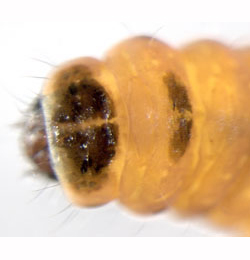|
||||||
|
Coleophora
gryphipennella (Hübner, 1796) Rose Case-bearer Tinea
gryphipennella
Hübner, 1796. Samml. Europ. Schmett.
8: 68, pl. 30 fig. 206. |
|||||||||||||||||||||||||||||||||||||||||||||||||||||||||||||||||||||||||||||||||||||||||||||||||||||||||||||||||||
|
Leaf-miner and case-bearer: The larva feeds on rose, building successively larger portable cases from cut-out leaf fragments; September 3mm, October to April 6mm. In mid-April the third and final, 6 or 7 mm, case is formed. At first it is spatulate with a bivalved anal opening and serrate dorsal keel formed from a leaf margin. During May, the case is expanded dorsally, becoming cylindrical with a trivalved anal opening. The expansion may conceal the dorsal serration (UKMoths). The leaf damage and case are also illustrated in British leafminers. The larvae, which hatch around the end of August make three cases during their lifetime. The final one, which they occupy after the hibernation, is a laterally flattened tubular leaf case with a dorsal toothed keel (remnant of the leaf margin from which the cases was excised). Mouth angle about 60° (Bladmineerders van Europa). Larva: The larvae of moths have a head capsule and chewing mouthparts with opposable mandibles (see video of a gracillarid larva feeding), six thoracic legs and abdominal legs (see examples). The larva is illustrated in Bladmineerders van Europa.
Pupa: The pupae of moths have visible head appendages, wings and legs which lie in sheaths (see examples). Adult: The adult is illustrated in UKMoths. The species is included in mothdissection.co.uk. Hosts in Great Britain and Ireland:
Hosts elsewhere:
Time of year - larvae: Late August to late October, then April to mid May. Time of year - adults: The adult occurs in late June - July, flying at dusk and early morning; males will assemble to an unmated female until 9 a.m. It can also be attracted to light at night (UKMoths). Distribution in Great Britain and Ireland: Apart from the far north of Scotland, it is common over most of Britain & Ireland where roses grow (UKMoths) including Anglesey, Bedfordshire, Breconshire, Buckinghamshire, Caernarvonshire, Cambridgeshire, Cardiganshire, Carmarthenshire, Cheshire, Derbyshire, Dorset, Dumfriesshire, East Gloucestershire, East Kent, East Norfolk, East Ross, East Suffolk, Elgin, Flintshire, Glamorgan, Herefordshire, Hertfordshire, Huntingdonshire, Isle of Wight, Kincardineshire, Linlithgow, Merionethshire, Mid-west Yorkshire, North Ebudes, North Essex, North Hampshire, North Northumberland, North Somerset, North Wiltshire, North-west Yorkshire, Pembrokeshire, Shropshire, South Hampshire, South Northumberland, South Somerset, South Wiltshire, South-east Yorkshire, South-west Yorkshire, Stafford, Surrey, West Cornwall, West Gloucestershire, West Kent, West Lancashire, West Norfolk, West Suffolk, Westmorland and Worcestershire (NBN Atlas). Also recorded in the Republic of Ireland (Fauna Europaea and National Biodiversity Data Centre Map). Distribution elsewhere: Widespread in continental Europe including Albania, Austria, Belgium, Bulgaria, Croatia, Czech Republic, Danish mainland, Estonia, Finland, French mainland, Germany, Hungary, Italian mainland, Latvia, Lithuania, Luxembourg, Norwegian mainland, Poland, Romania, Slovakia, Slovenia, Sweden, Switzerland and The Netherlands (Fauna Europaea). NBN Atlas links to known host species:
British and Irish Parasitoids in Britain and elsewhere:
|
|||||||||||||||||||||||||||||||||||||||||||||||||||||||||||||||||||||||||||||||||||||||||||||||||||||||||||||||||||
| Last updated 11-Jul-2019 Brian Pitkin | ||

